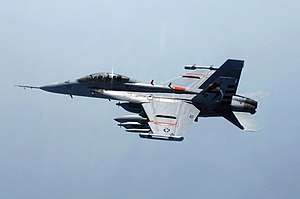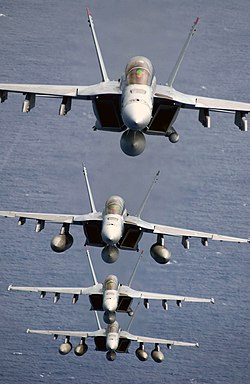In a
speech to the RSL, the
Prime Minister has indicated Australia would increase Defence spending in response to developments in the Asian region. However, defence systems take decades to acquire and Australia has had failures with such projects. But there are some quick and relatively easy, but not cheap, purchases which can be made : electronic warfare aircraft, landing helicopter dock and fast transport ships.
EA-18G Growler Electronic warfare aircraft
One quick and relatively easy purchase for Australia would be a dozen of the
EA-18G Growler aircraft. This is the electronic warfare version of the
F/A-18F Super Hornet, already ordered by Australia. These could be purchased off the shelf and would make the already ordered Super Hornets more effective. However, the Growler is not perfect: when equipped with its electronic warfare pods, it is slower that the standard F/A-18F. Also Australia would be dependent on the USA for maintenance of the complex electronic systems on board. Later versions of the
F-35 Lightning II Joint Strike Fighter are likely to incorporate many of the features of the Growler without a performance penalty, but the aircraft may not be available for decades, if ever.
Canberra class Landing Helicopter Dock ships. 
Australia could also order one or two more
Canberra class "Landing Helicopter Dock" (LHD) ships. These are aircraft carriers, in all but name, and would be useful for longer range operations. There is no fixed wing aircraft in production suitable for the LHD ships, but they could use various rotary wing manned and UAV aircraft. The could also use the the
F-35B is the short takeoff and vertical landing (
STOVL) variant of the F-35 when (if) it is available.
Hobart class of destroyersAustralia should add at least one, and perhaps more, to the existing order for three
Hobart class destroyers. These are coming from the same company building the LHDs and are to a proven design in use by the Spanish Navy, making a reasonably low risk for such a high technology platform. Extra ships would lower the per unit cost of the program and make training and logistics much easier than buying something different.
Australian made Joint High Speed Vessels
A complement to the Canberra class LHDs would be the production of a class of ships referred by the US DoD as
Joint High Speed Vessels (JHSV). Australian shipbuilders
Incat and
Austal are the world leaders in the design and building of JHSVs for the US DoD, but have been largely ignored by the Australian military.
In "
Widen the Lens for JHSV" (Proceedings of the U.S. NAVAL INSTITUTE, June 2008 Vol. 134/6/1,264), Commander Robert K. Morrison III and Lieutenant Commander Phillip E. Pournelle (U.S. Navy) suggests widening the role for JHSVs. For the cost of one Canberra class ship, the Australian Defence Force could have a fleet of low cost high speed multi-purpose ships. The JHSVs are ideal as helicopter platforms, due to their large deck area. Apart from the lower purchase cost, these would require a far smaller crew, reducing operating costs and recruitment issues. They could also be used for resupplying other ships and submarines, increasing their effectiveness.
Automation to Reduce Recruitment Issues
One aspect of the adapted civilian design of the high speed transport ships is their level of automation. Given the current difficulty in finding enough defence volunteers, Australia could invest in the automation of its existing and new weapons systems.
It is likely that Australia will want to build more of a
replacement for the Collins class submarine. Apart from the technical complexity and risk of the project, there is the problem of how to find the crew to operate them. One way is to increase the automation so fewer people would be needed. Also it is likely they will be equipped with
autonomous underwater vehicles (AUV) to extend their range (miniature robot submarines, about the size and shape of a torpedo).
... the task of an effective national security policy is to maximise the opportunities and minimise the risks.
Driving much of the change in our region will be the rise of China.
China will be the most dynamic major economy in the first half of this century - followed by India.
According to some estimates, by 2020 China will replace the United States as the world’s largest economy.
China’s economic growth will change the way it sees its own role in the world.
And it will change the way others see China – the Olympics are a great example of that.
Over the long term it is clear that China will have more political influence in our region.
Our other major Asian trading partner, Japan, will remain a major world economy even if it is not recording the growth rates of China.
An ageing population will have a major impact on Japan by 2050, with more than one-third of its population over 65.
But given its stature in the region and its continuing strength, Japan remains a major global and regional power.
The United States is likely to remain the world’s only superpower through to the mid-century.
Over the coming decades, the United States may see its position decline relative to other economies, but it will remain a major economic influence and a powerful source of ideas, innovation and technology in the global economy.
You only have to look at the US’s unmatched capacity for transforming new ideas into new technology.
The United States accounts for around one-third of all world patents.
By contrast, Australia accounted for 1.6 per cent and China 1.8 per cent in 2004.
The United States has shown time and time again that it can rise to any challenge and constantly evolve.
So nobody should ever underestimate the ability of the US to maintain its global leadership role.
The United States will also remain strategically dominant given the vast array of military capabilities available to future US administrations.
The Asia-Pacific region will become more prosperous and its population will continue to grow.
Militarily, however, as it has already become economically and politically, the Asia-Pacific will become a much more contested region.
The region’s total population will exceed four billion by 2020, or 56 per cent of the world’s total.
Australia’s population will only experience modest growth, growing to around 35 million by 2050.
But China’s population is expected to peak at around 1.5 billion in 2030.
India will near the 1.8 billion mark by mid-century.
Indonesia’s population could be as high as 350 million.
The demographic changes in our region will mean that by 2020 when we look to our north, we will see a very different region to the one we see now – one where population, food, water and energy resource pressures will be great.
We have to add one more element to this mix when we are looking at the future, and that is the existing military and political fault lines. ...
From: Address to the RSL National Congress, Kevin Rudd,
Prime Minister of Australia, 9 September 2008
Labels: Australian Government, defence, Defence IT, EA-18G Growler, F/A-18F Super Hornet, UAV
 On 11 September 2008 I suggested a relatively quick and easy purchase for Australian defence would be dozen EA-18G Growler aircraft. The Australian government has decided to do this, having 12 of the F/A-18F Super Hornet, which have already been ordered, wired for electronic attack. .This can be done for the relatively modest cost of A$35M, as the cable can be installed while the aircraft are being made.
On 11 September 2008 I suggested a relatively quick and easy purchase for Australian defence would be dozen EA-18G Growler aircraft. The Australian government has decided to do this, having 12 of the F/A-18F Super Hornet, which have already been ordered, wired for electronic attack. .This can be done for the relatively modest cost of A$35M, as the cable can be installed while the aircraft are being made.






